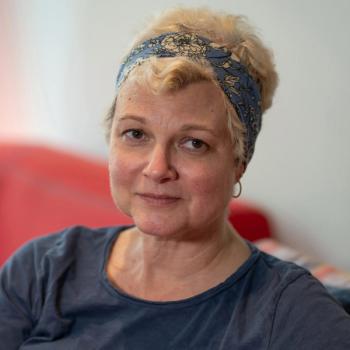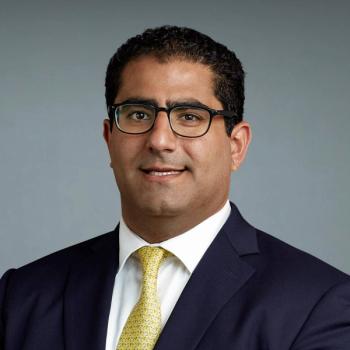
- Fall 2017
- Volume 1
- Issue 1
Social Disparities Affect Cancer Treatment and Outcomes
Socioeconomic status, race and other disparities among patients can affect cancer treatments and outcomes. Researchers are working to change that.
VALERIE MCDOWELL believes she got substandard cancer care due to socioeconomic factors. - PHOTO BY BOB RIVES
When Valerie McDowell, now 52, was diagnosed with breast cancer in 2006, she knew her journey would not be easy.
With surgery, chemotherapy and radiation all part of her treatment plan, she was prepared for a long haul. What she wasn’t prepared for was subpar care, which increasingly appeared to be linked to where she lived, the quality of her health insurance and the kinds of services her plan covered.
McDowell’s surgery, which took place at a Washington, D.C., hospital, went well, but the quality of her care deteriorated when she started chemotherapy, which her health insurance provider “outsourced.”
“The oncology center never felt right,” recalls McDowell, who had stage 2, estrogen receptor (ER)-positive disease. “It was more like an assembly line than a medical facility.
The waiting room was so crowded that people were standing outside. After blood was taken, there was more waiting, until someone ushered you into a room with 10 other people. I went through six rounds of chemotherapy over 18 weeks under these conditions.”
Her experience with radiation wasn’t much better. McDowell went back to the hospital for these treatments, which required a three-hour, round-trip commute by subway from her home in Temple Hills, Maryland. “The journey to the hospital from work and back for 33 straight days was longer than the actual radiation treatment,” McDowell says. “And because I pretty much doubled my transportation costs, I was fortunate that a co-worker gave me her fare card, which helped cut the costs and get me through.”
The ordeal was eye-opening for McDowell, who has a master’s degree and a good job at a Washington, D.C., nonprofit. It made her wonder how low-income people manage. “If transportation was an obstacle for me, I can only imagine what it’s like for them,” she says.
Unfortunately, McDowell’s experience is not unique. Shobha Srinivasan, Ph.D., research coordinator in the Health Disparities office of the Division of Cancer Control and Population Sciences at the National Cancer Institute, points out that several studies show that social determinants of health, such as geography, socioeconomic status, and access to and utilization of health care providers and health insurance coverage, are important predictors of outcomes for cancer patients. This often means that African-Americans and other minority populations receive lower-quality care and fare less well after receiving a cancer diagnosis.
PINPOINTING DISPARITIES
According to data from the Surveillance, Epidemiology, and End Results program sponsored by the National Cancer Institute, African-Americans have the highest incidence of, and death rates from, cancer compared with white people, Hispanics, Asian and Pacific Islanders and Native Americans. Among people of all those ethnic groups, African-Americans have the highest incidence of, and mortality rates from, colorectal and lung cancers. In addition, African-American men are at the highest risk of developing prostate cancer — often a more aggressive form.
African-American women, meanwhile, are more likely than those in other ethnic groups to develop triple-negative breast cancer, also a more aggressive subtype, at younger ages. Despite these risk factors, studies show that African- American patients are less often treated with necessary surgery for cancers such as breast or lung than their counterparts of other ethnicities, due to factors including their own belief systems, inadequate communication with physicians and physician bias. Of course, any or all of these dynamics can result in a less favorable prognosis.
Genetic factors may be responsible for some of these findings, but the quality of insurance also contributes.
“Access goes beyond having an insurance card,” says Karen Winkfield, M.D., Ph.D., associate professor of radiation oncology at Wake Forest Baptist Health and past chair of the American Society of Clinical Oncology’s (ASCO’s) Health Disparities Committee. “Although the Affordable Care Act (ACA) provided insurance to many people who had never had it before, some of those people have been unable to afford the deductible. As a result, they don’t go to the doctor. And some who do go feel like they’re not important — another reason they avoid care.”
Other ethnic groups also face challenges. Both Hispanics and Asian- Americans are disproportionately affected by cancers caused by infectious agents such as viruses. These include cervical cancer, largely caused by the human papillomavirus (HPV). Others are liver cancer, which results from hepatitis B, and some kinds of stomach cancer caused by H. pylori bacteria. These incidence rates could be reduced if better health care were provided to more people in these populations — for instance, via vaccines to protect against HPV and hepatitis B, or antibiotics when H. pylori signals its presence by causing gastritis.
“Because Asian-Americans don’t get the most common kinds of cancer, it sounds like they don’t have any problems with cancer,” says Moon Chen, Ph.D., M.P.H., associate director of cancer control and cancer disparities at the University of California, Davis, Comprehensive Cancer Center. “But this is not the case. In fact, the cancer burden for Asian-Americans is unique, unusual and unnecessary.”
In addition, geography can be a predictor of cancer outcomes. “People who live in rural areas often face significant health care access challenges, including fewer physicians, long distances to facilities and limited transportation options,” according to Srinivasan.
Electra D. Paskett, Ph.D., associate director for population sciences and program leader of the Cancer Control Program in the Comprehensive Cancer Center of the Ohio State University, concurs. Risky behaviors, such as smoking and poor diet leading to obesity, contribute to the high rates of cancer in these areas, says Paskett, who also studies cancer disparities in Appalachia.
Addressing these issues requires a multipronged approach, starting with knowledge of each community and the most effective way to reach its residents. A good general starting point, however, involves prevention and screening.
“To take advantage of mammography, Pap smears and colonoscopies, people must have access to care,” Winkfield says. “Not everyone does. On top of that, we have pockets of individuals who don’t understand why screening is important and that obesity and smoking are risk factors for cancer. That’s why education is so critical.”
TAILORING SOLUTIONS TO THOSE IN NEED
While communities share similar goals, such as increasing screening rates and pushing for behavioral changes, the paths toward achieving them vary considerably.
For example, in the African-American community, one of the biggest issues is establishing trust with a provider. “Often, African-American patients aren’t utilizing primary-care physicians the way they could,” Winkfield says. “Some of this may be attributed to the shortage of African-American doctors. I worked with a multiple myeloma patient who, though he had a fantastic oncologist, was feeling uncertain about his care. He felt more comfortable with me.”
ASCO is addressing this issue through a couple of workforce diversity initiatives.
Its medical school rotation for underrepresented populations pairs medical school students with clinical oncologists, who can serve as mentors to those interested in this career path.
The resident travel award provides funding for medical residents from underrepresented populations to attend ASCO’s annual meeting.
Community-based efforts targeting specific populations also show promise. In Chicago, 100 health care partners from 74 organizations came together to form the Metropolitan Chicago Breast Cancer Task Force in 2007. Its goal: to help eradicate breast cancer inequalities in the city.
The collaborative has sponsored many events to increase the number of women who have access to mammograms, including a 2012 initiative (called Beyond October!) that aimed to provide the screenings for free to 500 uninsured women throughout the city.
Efforts like this have made a difference. The results of a study published in Cancer Causes & Control in June 2017 showed that the Chicago program had an impact on breast cancer mortality. After comparing Chicago with nine other cities that have the largest African-American populations, the study team found that, compared with the 1999-2005 time frame, mortality rates declined by 13.9 percent between 2006 and 2013. This decline was the largest among the cities studied, followed by New York and Philadelphia.
“These findings point to the effectiveness of the collaborative that was instrumental in developing city/state policies to address the high mortality rate for breast cancer in the African-American community,” notes Srinivasan.
REACHING OUT IN RURAL AREAS
The obstacles are different in rural areas, where, even if women have the means to get screening done, they often don’t have services available nearby. For those women to have mammograms at all, the services must be brought to them.
That’s the thinking behind Paskett’s latest project in Columbus, Ohio. Working with patient navigators — people who guide patients through a complex health system and help connect them with services — women are identified to apply for an opportunity to get a free mammogram at any of 37 mobile clinics around the region. The service is available on 26 dates between April 2017 and March 2018 inside vans parked near churches and grocery stores.
Paskett’s work in Appalachia has touched many people with all types of cancer. One large initiative addressed cervical cancer, a big problem in these communities, and focused on increasing the number of girls who received the HPV vaccine.
“We were successful in getting more girls vaccinated, but the numbers were still low,” Paskett says. “Changes at the policy level may be needed to make an impact: For example, providing stronger incentives to parents for having their children vaccinated, or encouraging them in another way, may be necessary to increase vaccination rates.”
To address the issue of diet and exercise as preventive measures against cancer, Paskett and her team launched an ambitious program that cut across five of the states in Appalachia: Ohio, Kentucky, West Virginia, Pennsylvania and Virginia. Working with 28 churches, the team recruited 429 participants to track steps, respond to questionnaires about diet and discuss barriers to exercise, Paskett said.
“Through that study, we learned that this community isn’t into electronics,” Paskett said. “It was also really hard to get the Internet; the churches had dial-up service. Nonetheless, we found that men experienced significant weight loss. The in-person sessions proved to be most effective.”
CULTURAL BARRIERS AMONG ASIAN-AMERICANS
The causes for disparities among Asian-Americans transcend access to care or biological factors for disease.
Some Asian-Americans prefer speaking in their native languages or dialects, which health care providers often do not know, Chen says.
In terms of culture, he says, “some populations still have a traditional view toward life. For example, the Chinese traditionally don’t like to give blood. To them, blood represents life, and to take blood means taking away ‘life.’”
After learning about this issue through focus groups, Chen and his team developed a message to make giving blood more culturally congruent. They framed the issue around the higher cultural value of helping future generations.
When the request was presented in this way, these patients often agreed to give blood.
Many Asian-Americans have culturally based beliefs about screenings, as well. In their view, if they don’t feel sick, they don’t need to be vaccinated or screened. In fact, they don’t always want to know if they have a health problem.
“Telling them that early detection can lead to better care and a higher quality of life in the future helps them understand why screenings are important,” Chen says.
Cultural factors also help explain why, historically, Vietnamese American women have had the highest rates of cervical cancer in the United States. “In Vietnamese societies, most physicians are men, and their culture says that men shouldn’t touch women,” Chen says. “But as more physicians are trained in America, they realize that it’s important to have a nurse with them when examining their patients.”
In the United States, the rates of cervical cancer in Vietnamese American women declined significantly between 1990 and 2008, which Chen says can be attributed to the National Cancer Institute’s funding of cancer education in Vietnamese-Americans and to outreach to women from this ethnic group. “Both the provision of cancer education in appropriate languages, as well as tailoring messages based on culturally congruent values, will contribute to lower cancer rates for Asian-Americans,” he says.
NEXT STEPS
Although studies have shown that these initiatives are effective, they represent a fraction of what is needed. For example, patient navigators have been shown to increase screening rates, but the data are unclear about whether this makes a difference in mortality rates. Part of the problem, Winkfield says, is the lack of funding to add such programs where they are needed most. “Academic centers have a little bit more of a margin, but under-resourced cancer practices, serving patients who are uninsured or on Medicaid, can’t afford these services,” she says.
These patients also lack access to cutting-edge treatments, because people from minority and rural communities tend to be less likely to enroll in clinical trials.
According to Srinivasan, studies have shown that such patients are unaware of trials, have difficulty traveling to these sites and lack the support they need to participate.
“Patient navigation works hand in hand with helping patients (who are) typically under-represented in clinical trials (to) find out about them and sign on when they can,” she says.
Over time, investigators have gathered a robust body of research that can serve as a foundation for action-oriented projects, and experts say it is crucial that the field move in this direction.
“Some researchers have made a career of analyzing large databases that simply show, over and over again, that race-based differences in outcomes persist, independent of cancer stage and treatment,” Winkfield told ASCO in an interview. “The research community needs to move away from simplistic reporting of disparities and instead focus on strategies designed to change the landscape of cancer disparities.”
Articles in this issue
almost 8 years ago
Comments From Our Readers on Our Fall 2017 Issuealmost 8 years ago
Moving Forward With Confidence and Dignityalmost 8 years ago
The Healing Arts in Palliative Carealmost 8 years ago
Nurse Uses Her Cancer to Improve Treatment of Othersalmost 8 years ago
New Options Are Being Explored in Ovarian Canceralmost 8 years ago
Defining Cancer Survivorshipalmost 8 years ago
Confronting the What-Ifs of Cancer During Pregnancyalmost 8 years ago
Labor of Love: Tailoring Cancer Treatment for Pregnant Womenalmost 8 years ago
Using Hypnosis to Treat Cancer's Side Effects




